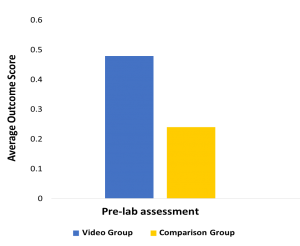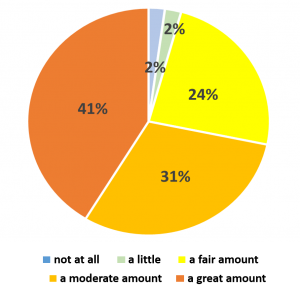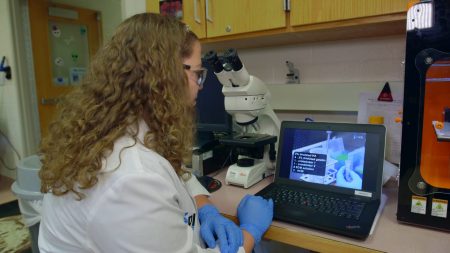Since 2010, JoVE has been creating and releasing science education video collections for undergraduate and graduate classes in multiple fields. The general feedback we have received from our community of users, authors, and librarians has always been quite positive. But we wanted to move past anecdotal feedback and really dig into the effect our videos were having in the classroom. We are happy to announce that we have quantitative and evidence-based feedback about JoVE Science Education videos, and the numbers are good!  Overall the results of the study suggested positive learning experience and improved performance from watching JoVE videos prior to lab. The findings confirm that students who watched a JoVE video performed up to 2X better in pre-lab exams – in comparison to students who just read lab handouts. A high percentage of students who watched the videos also reported high positive perception in terms of confidence and comprehension.
Overall the results of the study suggested positive learning experience and improved performance from watching JoVE videos prior to lab. The findings confirm that students who watched a JoVE video performed up to 2X better in pre-lab exams – in comparison to students who just read lab handouts. A high percentage of students who watched the videos also reported high positive perception in terms of confidence and comprehension.
The study was conducted by an education research organization from Cambridge, Massachusetts, called TERC. Their researchers conducted an independent study at DeSales University and Clemson University during the Fall semester in 2017, measuring the efficacy of JoVE videos as a pre-lab learning resource for undergraduate biology students.
In case you missed it, we released a 22-page report and a three-page whitepaper summarising the details and findings of this study on January 31, 2018. You can download both, for free, at this web link.
Here are some key takeaways from the study for those of you in the higher education community looking for ways to enhance existing teaching practices and resources.
These eight takeaways listed below – help clarify some of the key questions STEM educators and e-resource librarians often ask – before choosing a new resource for their classrooms or institutions.
-
How do I know this is the best resource for my students?

You should search out evidence to back your decision. Study findings show that pre-lab viewing of JoVE videos helped students perform up to 2X better on lab quizzes in comparison to students who just read the text-material.
“For the Plasmid Purification lab, the outcome scores of students who watched videos were as much as two-fold higher in the pre- and post-lab assessments than the comparison group. In the SDS PAGE lab, students who watched videos scored as much as 42% higher, on average than the comparison group in pre- and post-lab assessments. Our analyses show highly significant results (p<0.001).” (as stated in the report)
-
Why advise students to watch the video before coming into lab versus in-lab or post-lab?

When students are able to visualize an experiment or demonstration in advance of a lab, the familiarity helps them feel more confident about the lab in general. That leads to better results.
“For the SDS PAGE video, 89% of students reported an increase in confidence, 92% reported a better understanding of the laboratory techniques and 96% reported better comprehension of the scientific concepts.” (as stated in the report)
-
Isn’t it time-consuming for students to review additional material before class?
In fact, it is quite time efficient. Each lab in your existing science and engineering undergraduate curriculum can be enhanced with just 10 minutes of video. The results in this study occurred after professors instructed students to watch only the first 5 or 6 mins of the video.
“Students watched the first 5:55 minutes of this video, as that portion provided an overview of the topic, principal components, and step-by-step procedures for plasmid purification that were relevant to their DNA and Enzymes lab.” (as stated in the report)
-
I am hesitant about disrupting or changing my current teaching process.
We understand and that’s why we are suggesting videos as a supplement to your current instruction and reading materials, not to replace them.
Introducing these videos as pre-lab material did not disrupt in any way what the instructor was already doing. They got to keep everything in their existing curriculum but just asked students to watch a video in addition to reading – before coming into the lab or class.
-
Students have diverse learning behaviors – how do I know if videos are the best resource for all types of students?

Students’ limited attention span is often a challenge for many instructors and they are always looking out for ways to keep their students engaged.
“JoVE videos stand out for their brevity. The students’ attention is short, and lab time is precious … the JoVE videos covered the most important parts and left out the needless detail. It kept the students’ attention, and it shows in their results.” – Dr. Lara Goudsouzian, DeSales University
Students get to watch a video at their own pace and space – giving them enough opportunity to be up to speed with concepts and techniques which need familiarity, ahead of a lab.
“Their first exposure to a new equipment (which others may have seen) is in a non-threatening place – in their dorm room, on their computer. No one is going to judge them for not ever seeing one before or bumbling around with it the first time.” – Prof Christine Minor, Clemson University
-
Are the videos and the study relevant for science majors or intro-level students?
Actually, both! The study was conducted with two different set of students – science major and non-science major students. This is a good representation to do an efficacy study and understand the impact of video on a wider variety of students.
At DeSales University… “94 students in a molecular biology course participated in the study. Most were sophomores who were part of the accelerated Physician Assistant program. About 25% of the students were majoring in biology.” (as stated in the report)
At Clemson University…. “252 students in a biology course participated in the study. Students ranged from freshman to seniors, and all were taking the course to fulfill a core requirement, as none were majoring in a science field.” (as stated in the report)
-
Tell me a little bit more about the group that led this study.
TERC is an independent, research-based organization located in Cambridge, MA – dedicated to improving mathematics and science education for all students. For over 50 years, they have worked at the frontiers of theory and practice to develop and enhance instruction, curriculum, and new technologies.
This study was led by Dr. Karen Mutch-Jones – Senior Researcher and Co-Director of the STEM Education Evaluation Center at TERC. Dr. Mutch-Jones received her Ed.D. from Harvard University and has served as Principal Investigator and lead evaluator on several National Science Foundation projects.
-
I want to bring JoVE Science Education videos to my classroom or institution – what do I do next?
First, take a look at the library of collections available across eight different disciplines in medicine, science, and engineering. If any of those topics look like a good fit for you please reach out to our library liaison team at JoVE.
One of my favorite science communicators – astrophysicist Dr. Neil DeGrasse Tyson once said, “Dreams about our future are always filled with gadgets.” Let that gadget for our current and future generation of STEM students be JoVE!
This is the age of digital education. Let’s start modernizing our classes so our students see the possibilities of what they can do and achieve.


